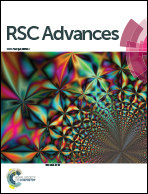Facile synthesis of a nickel vanadate/Ni composite and its electrochemical performance as an anode for lithium ion batteries†
Abstract
Ni3V2O8/Ni composites were prepared by a simple one-step hydrothermal route and they showed superior electrochemical performance as anode materials for Li-ion batteries. They had a unique three-dimensional (3D) architecture, in which interlaced Ni3V2O8 nanosheets and nanoflakes were uniformly grown on Ni foam. The Ni3V2O8/Ni composites delivered a discharge capacity of 1626.1 in the initial cycle at a specific current of 200 mA g−1, maintaining 1286.8 mA h g−1 after 100 cycles. After 600 cycles at 1000 mA g−1, the discharge capacity was maintained at 941.3 mA h g−1, and even when the current was 10 A g−1, a discharge capacity of 477.7 mA h g−1 was achieved. The excellent lithium storage performance of the Ni3V2O8/Ni composites could be attributed to their unique 3D architecture, favorable electrochemical reconstruction in cycling and their intimate contact with the Ni foam substrates, which offered fast electrical and ionic transport, provided a sufficient electrode/electrolyte contact area and facilitated accommodation of strain during lithiation/delithiation cycling. In addition, details of the electrochemical reaction process of Ni3V2O8 were carefully investigated to discover the conversion and intercalation reaction routes. Such novel Ni3V2O8/Ni composites might provide insight for the use of metal vanadate as an energy storage material.



 Please wait while we load your content...
Please wait while we load your content...